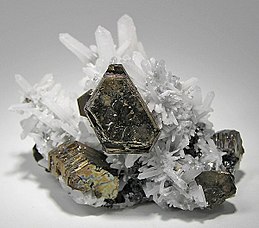
Back Magneetkies Afrikaans بيروتيت Arabic Pirrotin Azerbaijani Pirrotina Catalan Pyrhotin Czech Pyrrhotin German Πυρροτίτης Greek Pirotino Esperanto Pirrotina Spanish Pirrotita Basque
| Pyrrhotite | |
|---|---|
 Brassy, tabular crystals of pyrrhotite, with sphalerite and quartz, from Nikolaevskiy Mine, Primorskiy Kray, Russia. Specimen size: 5.3 × 4.1 × 3.8 cm | |
| General | |
| Category | Mineral |
| Formula (repeating unit) | Fe1−xS (x = 0 to 0.125) |
| IMA symbol | Pyh[1] |
| Strunz classification | 2.CC.10 |
| Crystal system | Monoclinic, with hexagonal polytypes |
| Crystal class | Prismatic (2/m) (same H-M symbol) |
| Space group | A2/a |
| Unit cell | a = 11.88 Å, b = 6.87 Å, c = 22.79 Å; β = 90.47°; Z = 26 |
| Identification | |
| Color | Bronze, dark brown |
| Crystal habit | Tabular or prismatic in hexagonal prisms; massive to granular |
| Cleavage | Absent |
| Fracture | Uneven |
| Mohs scale hardness | 3.5 – 4.5 |
| Luster | Metallic |
| Streak | Dark grey – black |
| Specific gravity | 4.58 – 4.65, average = 4.61 |
| Refractive index | Opaque |
| Fusibility | 3 |
| Solubility | Soluble in hydrochloric acid |
| Other characteristics | Weakly magnetic, strongly magnetic on heating; non-luminescent, non-radioactive |
| References | [2][3][4] |
Pyrrhotite (pyrrhos in Greek meaning "flame-coloured") is an iron sulfide mineral with the formula Fe(1-x)S (x = 0 to 0.125). It is a nonstoichiometric variant of FeS, the mineral known as troilite. Pyrrhotite is also called magnetic pyrite, because the color is similar to pyrite and it is weakly magnetic. The magnetism decreases as the iron content increases, and troilite is non-magnetic.[5] Pyrrhotite is generally tabular and brassy/bronze in color with a metallic luster. The mineral occurs with mafic igneous rocks like norites, and may form from pyrite during metamorphic processes.[6] Pyrrhotite is associated and mined with other sulfide minerals like pentlandite, pyrite, chalcopyrite, and magnetite, and has been found globally.



- ^ Warr, L.N. (2021). "IMA–CNMNC approved mineral symbols". Mineralogical Magazine. 85 (3): 291–320. Bibcode:2021MinM...85..291W. doi:10.1180/mgm.2021.43. S2CID 235729616.
- ^ Cite error: The named reference
mindatwas invoked but never defined (see the help page). - ^ "Pyrrhotite" (PDF). Rruff.geo.arizona.edu. Retrieved 2015-07-10.
- ^ "Pyrrhotite Mineral Data". Webmineral.com. Retrieved 2015-07-10.
- ^ Haldar, S. K. (2017). Platinum-nickel-chromium deposits : geology, exploration and reserve base. Elsevier. p.12 ISBN 978-0-12-802041-8.
- ^ Cite error: The named reference
Maukwas invoked but never defined (see the help page).
© MMXXIII Rich X Search. We shall prevail. All rights reserved. Rich X Search